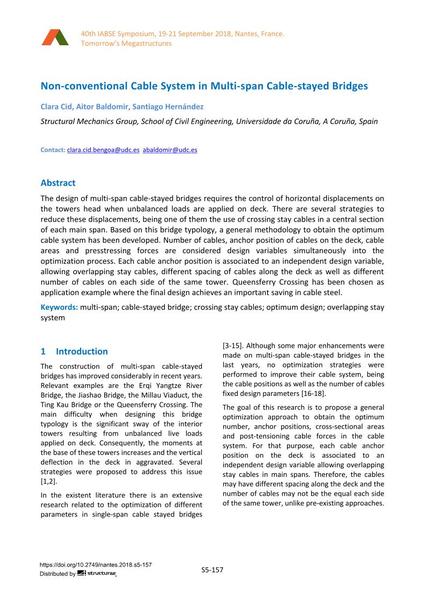Non-conventional Cable System in Multi-span Cable-stayed Bridges

|
|
|||||||||||
Bibliographic Details
| Author(s): |
Clara Cid
(Structural Mechanics Group, School of Civil Engineering, Universidade da Coruña, A Coruña, Spain)
Aitor Baldomir (Structural Mechanics Group, School of Civil Engineering, Universidade da Coruña, A Coruña, Spain) Santiago Hernández (Structural Mechanics Group, School of Civil Engineering, Universidade da Coruña, A Coruña, Spain) |
||||
|---|---|---|---|---|---|
| Medium: | conference paper | ||||
| Language(s): | English | ||||
| Conference: | IABSE Symposium: Tomorrow’s Megastructures, Nantes, France, 19-21 September 2018 | ||||
| Published in: | IABSE Symposium Nantes 2018 | ||||
|
|||||
| Page(s): | S5-157 | ||||
| Total no. of pages: | 8 | ||||
| DOI: | 10.2749/nantes.2018.s5-157 | ||||
| Abstract: |
The design of multi-span cable-stayed bridges requires the control of horizontal displacements on the towers head when unbalanced loads are applied on deck. There are several strategies to reduce these displacements, being one of them the use of crossing stay cables in a central section of each main span. Based on this bridge typology, a general methodology to obtain the optimum cable system has been developed. Number of cables, anchor position of cables on the deck, cable areas and presstressing forces are considered design variables simultaneously into the optimization process. Each cable anchor position is associated to an independent design variable, allowing overlapping stay cables, different spacing of cables along the deck as well as different number of cables on each side of the same tower. Queensferry Crossing has been chosen as application example where the final design achieves an important saving in cable steel. |
||||
| Keywords: |
cable-stayed bridge optimum design multi-span crossing stay cables overlapping stay system
|
||||

